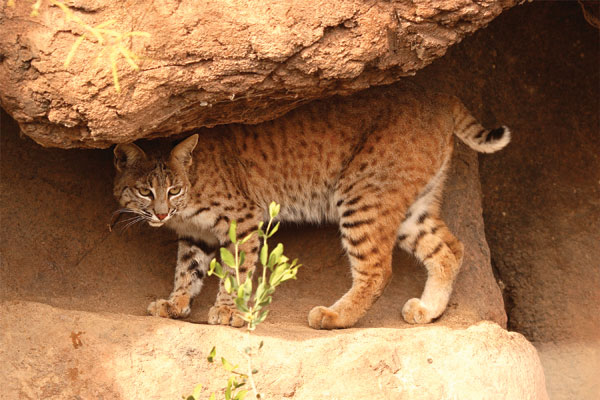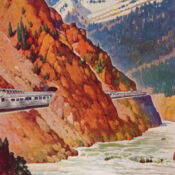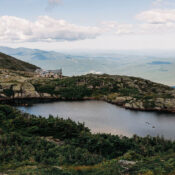4. Animals can kill the inattentive quite easily.
But there are ways around their teeth, their spines, their stingers. Arizona Game and Fish’s advice for dealing with a bobcat in your backyard is “just throw a rock at it.”
This also works on coyotes, on snakes, on lizards (of course, the only poisonous lizard, the Gila monster, has all the speed of moss growing). Rocks work on mountain lions, scorpions, and javalinas. Tarantulas, as I once found out much to my surprise, have no fear and can jump really high, so it’s better just to walk away.
Maybe rocks work on turkey vultures, but if vultures are close enough for you to throw rocks at them, you most likely have other, much more severe problems.
5. The desert thrives on problems. It’s never what you expect, never the same two days in a row.
My dog and I walk this trail a couple times a week, but the light changes the shape of the rocks—how long was it before I noticed the formation that looks like a dinosaur skull?—grass and wildflowers sprout from the dead brown ground hours after a rainfall, and the trail sometimes seems to move with the wind.
The desert is like one of those haunted mansions where doorways disappear, windows slam shut just as you’re an instant from escaping. Topo maps are useless, because the contour lines never match reality. Compasses go wild from mineral deposits.
In the Superstition Mountains, the city’s eastern border, people have searched for the Lost Dutchman’s Mine for more than a hundred years. It’s the standard story: A man walks out of the desert, his eyes burned by summer, his donkey loaded with gold. He drops dead before he can tell anybody where the mine is. Which brings us to…
6. Always blaze your trail.
But know that finding your way back will still be iffy, because time and space are different here, as mutable as the angle of sunlight.
In a wet year, when there’s lots of rain, city motorists drive into flooded washes and get rescued on live TV—Arizona’s version of the high-speed chase. The desert goes Technicolor, brittlebush covered in yellow flowers, hummingbirds with iridescent throats fighting for space where ocotillos shoot red blooms out of what looks like firewood tinder. The barrel cacti soak up so much rain that their pleats expand like a fat man’s beltline at Thanksgiving. Five or six species of aloe can hold so much water that touching them is like touching warm ice.
In a dry year, like this one, there’s a sense of waiting. Even the smallest rainfall will cause plants to spring, even if only for a couple hours. That’s because…
7. Summer is always coming.
In summer, the air is a mugger. You catch the first hint of it in early spring, when the desert smells like a rainstorm caught in a clothes dryer.
The heat starts in earnest around late April, maybe the beginning of May. All those Midwesterners, who flee the snows back home for the Arizona winter sun, slam their cars into reverse. By June, the thermometer has left the 90s behind without a backwards glance. In my Boy Scout days, there was a three-week span where every day was over 115 degrees. We walked barefoot to the local pool, and our feet got so tough that at home we used thick needles to sew yarn patterns in the soles.
All over the city, great horned owls leave bone and feather pellets in backyards. People put the crib legs in jars of water to keep scorpions away from the baby. You don’t walk out the front door unless you’re carrying water the way the Secret Service carries the briefcase of nuclear codes.
We who grew up here are lucky that nobody ever told us this isn’t a normal way to live. My dog checks another bush, her tongue hanging out. She won’t drink until we get back to the car, because she doesn’t know the rules. And that’s what got the Nazis. Absolutely no understanding of the rules. They escaped from the prisoner-of-war camp that during World War II covered a good chunk of this park. A couple days later, covered in cactus spines, their lips cracked like desert sand from thirst, utterly and hopelessly lost, the Nazis said, “Verdammt und zugenäht,” and turned themselves in to the first person they saw. To them, the prison camp had easier rules than the desert.
Dog and I head toward cool water, while the coyote trots off, looking for the filling calories of a ground squirrel.
Once you know the rules, once you’ve seen the way a dust storm covering 50 miles of horizon rolls into the August sky, once you’ve seen the mountains catch the twilight and hold it for hours through enough shades of red to make the Crayola company give up in frustration, once you’ve seen a coyote watching you, just in case you are worth watching, the landscape makes the perfect sense of home.
Also see: Where to Stay, What to See in Arizona.
Become a Saturday Evening Post member and enjoy unlimited access. Subscribe now




